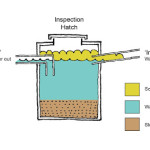Poop 2, The Sequel.
By Rory
View original post on the Camps International Project Blog
Following on from my last post about the Bio Gas collector (Human waste is where its at), I want to now run you through our progress to date. Before I do that below is a sketch drawing of whats involved in the construction. Basically several tanks joined together, a bit of wizardry with water pressure and balancing and a domed lid with a pipe coming off it.
Our plan is to build our very own bio gas collector as a prototype so that we can demonstrate the technology and building requirements to interested parties in the hope that they can role it out in different locations. In addition we hope to be able to start building them for remote rural communities with sufficient “poop” capacity to make them worthwhile. We may start this process in the community of Tinangol where people live very closely together and it lends itself to their use – we will see!
The process of building the collector is actually relatively simple which I will show here with a number of pictures. Firstly a large hole is dug and a concave concrete base laid.
Then a basic double skinned brick wall is laid to just above the surface including the rectangular balancing tank on the side.
These are then skimmed with concrete to make sure they are water (poop!) tight.
Drains and sewage inlet/outlet pipes are then laid including an additional “mixing” inlet to allow kitchen and other biodegradable waste to be added.
Then comes the tricky part of constructing the dome – we have opted to do this using ferro-cement building technique – this is basically iron rods bent into shape, covered with a fine mesh and then plastered with cement to provide a smooth internal and external surface. This is then secured onto the main tank using more iron work ensuring it doesn’t fly off under huge gas pressure.
The final task is connecting all the piping and diverting the “poop” flow into the digester.
In order to fully monitor and assess its efficiency we have devised a simple volume measurement for waste going in – and people think I am mad when I tell them but we plan to have a clip board in the toilets. On this people will tick whether they “laid” a small, medium or large (I will have to quantify these!) “package” and also what was its consistency (fluid, normal or rock) and how many pans of water to flush it away. Hopefully this should give us an idea of volume of waste to water.
And that’s about it so far – we will be connecting the one at Tinangol very soon and will be building one for the new Sun Bear Conservation Centre at Sepilok Orangutan Sanctuary this month. I will keep you posted of progress and if you are really interested the volumes!! Happy crapping everyone!!
Related posts










